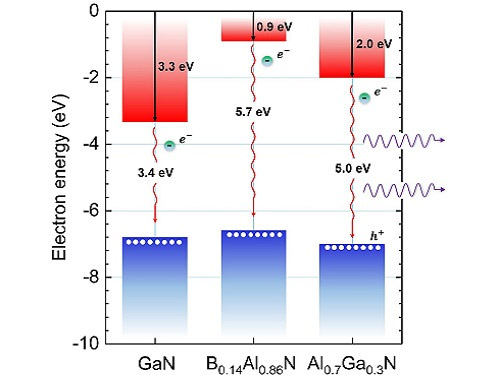- News
15 December 2017
KAUST/Georgia Tech team determines band alignment at BAlN/AlGaN heterojunction
© Semiconductor Today Magazine / Juno Publishing
Haiding Sun and principle investigator Xiaohang Li of Saudi Arabia’s King Abdullah University of Science and Technology (KAUST) and coworkers at the Georgia Institute of Technology in the USA have experimentally measured the alignment of the two large-bandgap materials boron aluminum nitride and aluminium gallium nitride (H Sun et al, ‘Band alignment of B0.14Al0.86N/Al0.7Ga0.3N heterojunction’. Applied Physics Letters 111, 122106 (2017)).
Compared with 3.4eV for gallium nitride (GaN), aluminum nitride (AlN) has a much larger bandgap of 6.1eV. Materials with a large bandgap are useful in high-power electronics because they have larger breakdown voltage for energy-efficient transistors compared with narrow-bandgap materials, such as silicon. They can also produce light deep into the ultraviolet part of the spectrum, making them useful for disinfection and water purification.
The electronic properties of aluminum nitride can be tuned by replacing some of the aluminium atoms in the crystal with either boron or gallium. Such materials can be tailored to a specific application by layering different semiconductors to create a heterostructure with the desired properties. However, it is vital to understand how the bandgaps of two semiconductors align when they are brought together in this way.
The KAUST/GeorgiaTech team created an interface between boron aluminium nitride (with a boron to aluminium atom ratio of 14:86) and aluminium gallium nitride (with a gallium to aluminium ratio of 30:70) on an AlN-covered sapphire substrate.

Graphic: Bandgaps and band alignments of B0.14Al0.86N and Al0.7Ga0.3N compared with GaN.
They used high-resolution x-ray photoemission spectroscopy (XPS) to measure the offset between the top and the bottom of the two material’s bandgaps. They show that the bandgaps have a staggered alignment, with both the top and bottom edge of the bandgap of the Al0.7Ga0.3N lower than the respective edge in B0.14Al0.86N (pictured).
“Based on the experimental results, we can achieve a much higher amount of two-dimensional electron gas sheet carrier concentration in such junction,” notes Sun. “Determination of the band alignment of B0.14Al0.86N/Al0.7Ga0.3N heterojunction provides valuable support in the design of optical and electronic devices based on such junctions,” he adds. Insight could help to improve the efficiency of light-emitting optoelectronic and high-power electronic devices, it is reckoned.
http://aip.scitation.org/doi/10.1063/1.4999249


